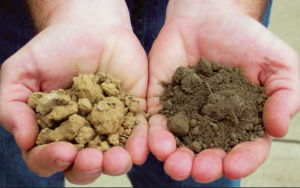Spring Gardening Checklist
While spring technically begins on March 21, it is vital that you consider the climate zone of your current location, to determine the potential danger of frost. Most plants tend to thrive in frost free conditions, where the soil will be at least a couple degrees above freezing. When it comes to gardening, spring starts when the soil says so. There are a myriad of tools that you can utilize to help determine your current climate zone via zip code. If you think that your area has passed the danger of frost, then use a soil thermometer to double check. It is recommended that the soil is on average, 50 degrees Fahrenheit or higher. Once you know that you have passed the danger of frost, then you can prepare for spring gardening.
 Surveying the yard and completing a soil test. If you have trees in your yard, make sure that their limbs aren’t overhanging on structures. This may require you to hire an arborist, especially if you have large trees. Remove last year’s perennial foliage, and inspect your drainage and ditches. Leaves and other organic and inorganic material tend to gather in the drainage area over the winter. Make sure that spring rains have a place to drain off by removing this debris. Spring seedlings need proper drainage for them to grow. Remove dead leaves, branches, and toss them into your compost. If necessary, refresh mulch in your planting areas. Before planting new seeds, check the pH of your soil with a home kit. Take several samples from different areas in your garden for an accurate reading of your yard’s overall health. You may need to add lime to raise the pH of your soil or elemental sulfur to reduce it.
Surveying the yard and completing a soil test. If you have trees in your yard, make sure that their limbs aren’t overhanging on structures. This may require you to hire an arborist, especially if you have large trees. Remove last year’s perennial foliage, and inspect your drainage and ditches. Leaves and other organic and inorganic material tend to gather in the drainage area over the winter. Make sure that spring rains have a place to drain off by removing this debris. Spring seedlings need proper drainage for them to grow. Remove dead leaves, branches, and toss them into your compost. If necessary, refresh mulch in your planting areas. Before planting new seeds, check the pH of your soil with a home kit. Take several samples from different areas in your garden for an accurate reading of your yard’s overall health. You may need to add lime to raise the pH of your soil or elemental sulfur to reduce it.
Remove seedling-killing weeds. Weeds are the worst enemies of young plants as it robs your garden of proper nutrients. Particular weed strains can be fast-growing, quickly overshadowing your growing plants, potentially killing them. Even though you should be diligent of weeds even during the cooler months, chop off current weeds right below ground level.
Consider pruning. If you have neglected your garden, then your yard may look under the weather. For your spring garden, prune your flowers, shrubs, and trees. By pruning, you are supporting new growth, as well as encouraging flowering plants. If self-pruning, make sure that you cut at a 90-degree angle, right in front of a leaf cluster. Cut us close to the part that you want to keep, without actually cutting into it.
Preparing new beds for planting. After removing debris and weeds, spread about 4 to 5 inches of compost over the soil, then use a spading fork to cultivate up to a foot deep. Transfer container plants into the appropriate hole of suitable depth. You may want to consider planting:
- Spinach. It grows quickly and is surprisingly handy when it comes to cooking. There are a large variety of spinach plants, but most are of the crinkled or curly leaf variety. If this is your first time with spinach, then you can mix the variety to compliment the theme of your garden.
- Radishes. One of the more fast-growing vegetables that you can grow. Radishes can be harvested in just a couple of weeks after being planted.
- Peas. Take about 50 to 65 days to mature, and make a great spring vegetable that is works with most palates.
If you live in an area that tends to have an intermittent or irregular frost season, then consider planting frost-resistant plants. This includes sweet peas, rose mallow, and sweet alyssum. For tolerant vegetables consider broccoli and cauliflower. It is best to screen newly planted seeds with a cover, or keep them potted indoors, until you are confident that the frost season has passed. Consider adding an extra layer of protective mulch, as it is a useful protector against the sting of icy weather.
Posted in: Gardening
Leave a Comment (0) ↓